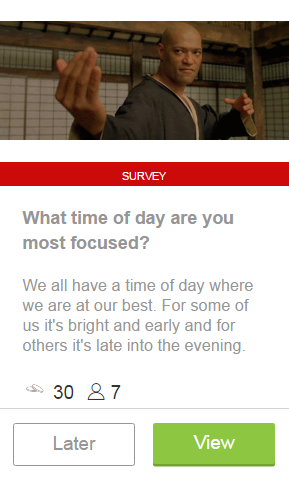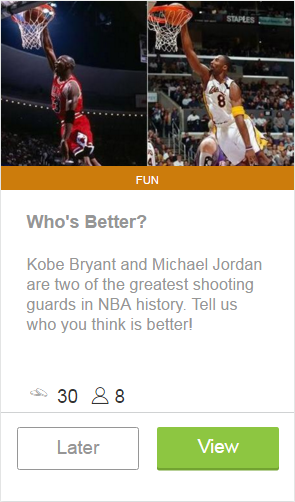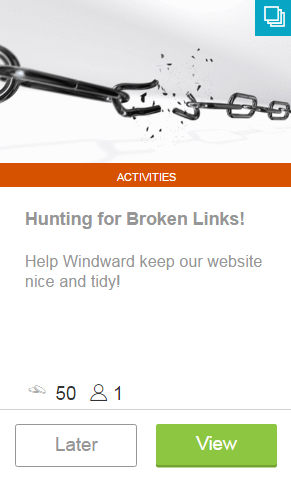Are you getting the most out of your customer advocates?
I’m an advocate marketer at Windward Studios, a reporting and docgen software company. Like many AdvocateHub customers in the IT field, I quickly learned that we would have two challenges when it came to engaging our customer base:
- To start, there are simply fewer IT customers interested in joining what they assume is a traditional rewards program.
- Overall, the IT persona tends to be more skeptical and hesitant to engage in online programs.
Hurdles like these can cause a program to start slow. But I quickly discovered that when you cater your program to the IT advocate personality, they will often go above and beyond to deliver high-quality acts of advocacy.
To do that, I created challenges in our AdvocateHub that helped me learn more about our advocates who were engaging in the program. Once I had this information, it was easier to build trust with our advocates—which helped us generate more (and better) acts of customer advocacy from those who do engage with the program.
Below, are a few things I’ve learned about our IT advocates to help other program managers discover some unique ways to rev up their AdvocateHubs and get the best ROI from their advocate base.
(While these tips are focused on IT advocates, you could apply them to your own advocate marketing program so you can get closer to your advocates.)
Lesson 1: Test and discover the perfectly timed challenge notification email
If your advocates are mostly IT folks, it’s important to remember their work days are usually different than many other employee workdays. They need significant periods of uninterrupted work time and will often come into the office early or stay late when there are fewer people around to disturb them.
It’s said that it takes 20 minutes for a person to refocus once distracted, and the last thing you want is for your notification email to be that interruption. Poorly timed or frequent emails can cause advocates to unsubscribe from notifications. Once an advocate does this, you can assume that they will go dormant (if not permanently inactive). With a smaller number of customers interested in joining your program in the first place, you have to treat each one like gold and only send emails when the time is right.
By respecting your advocate’s work day, you can strategically offer a break from what they are working on and eventually be their go-to site when they get a little free time.
Put it into practice: Create a survey challenge that asks your advocates what time of day they are most focused, or simply group your advocates based on their time zones. You can then get an idea of when to avoid sending notification emails.
Lesson 2: Determine your advocate age demographic and interests
Developing challenges—especially fun challenges—is an art. Using mainstream media references your advocates don’t find interesting can actually hurt your AdvocateHub engagement levels.
Advocate marketers should put extra time into creating different challenges with different pop culture references to get a feel for what their customers like. What an entry-level millennial may find amusing, a CTO boomer may not.
Put it into practice: Create “this or that” challenges. For example, show them a photo of Michael Jordan and Kobe Bryant and ask them who is best. You can do this for all kinds of topics to get insights on their demographics interests, which will influence engagement.
Next, track who is completing what challenges and adjust accordingly. When in doubt, run with all-inclusive mainstream topics such as the Olympics or hallmark holidays.
Lesson 3: Recognize and reward your advocates’ unique skill set
Having an IT advocate audience means you have one of the most intelligent customer bases out there. They aren’t always going to be interested in silly challenges that took you two minutes to create. If the challenges are too easy or have errors, your advocates will get bored.
We’ve found that our IT advocates want to teach and demonstrate their knowledge. So, at Windward, we reward (or “perk”) any advocate who notifies us about a mistake in a challenge or gives us feedback that will help improve the program in some way. By rewarding and encouraging their tendency to find and fix problems, they’ve often come back to the program.
Put it into practice: Go out of your way to thank advocates when they mention problems with challenges, such as broken links or typos, by perking them some points. Take opportunities to solicit their feedback so you can improve your program based on their suggestions. This will build reciprocity, encourage engagement and improve your AdvocateHub in the process.
Sometimes knowing what not to do with your advocates is just as important as knowing what to do. Using your challenges to get a deeper understanding of your advocates’ behaviors and preferences can provide direction for making your advocate marketing program the best it can be.
Let me know any tips or tricks you have developed to make the most of your advocate audience!














































